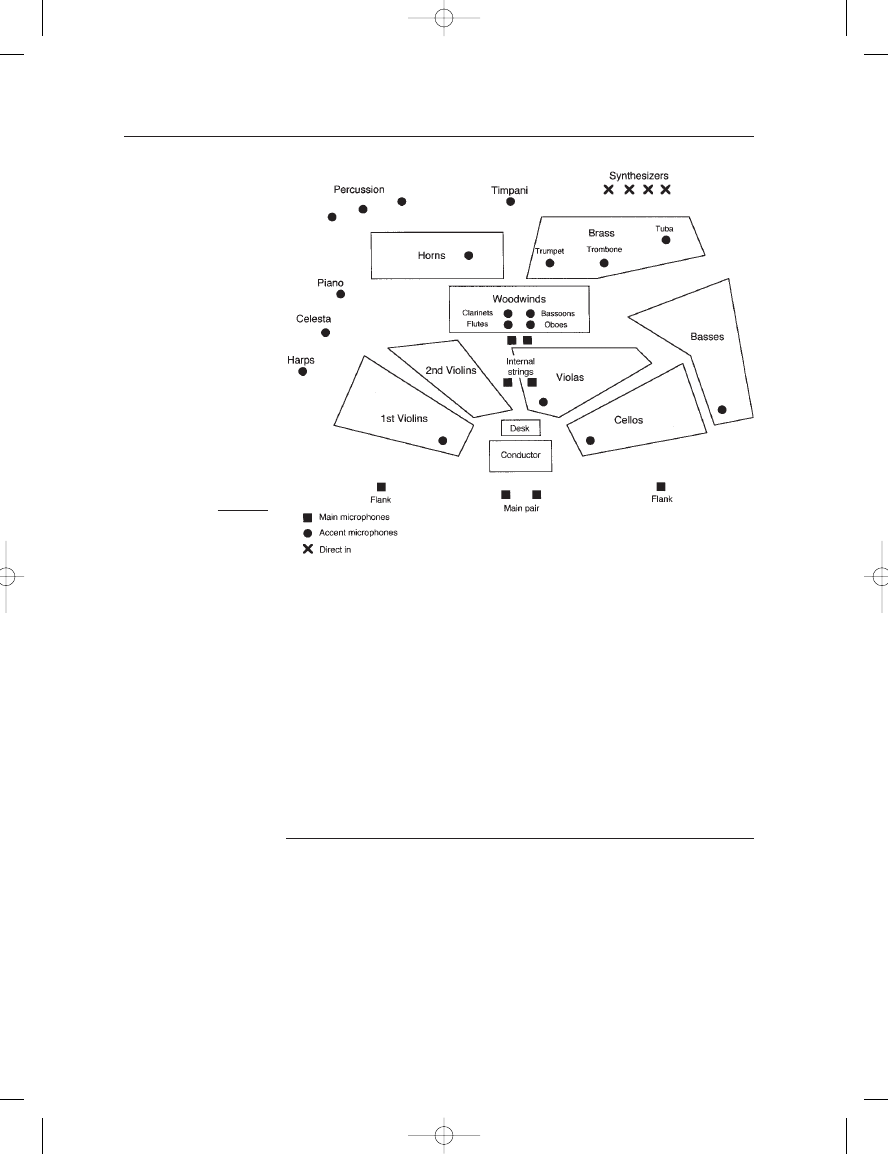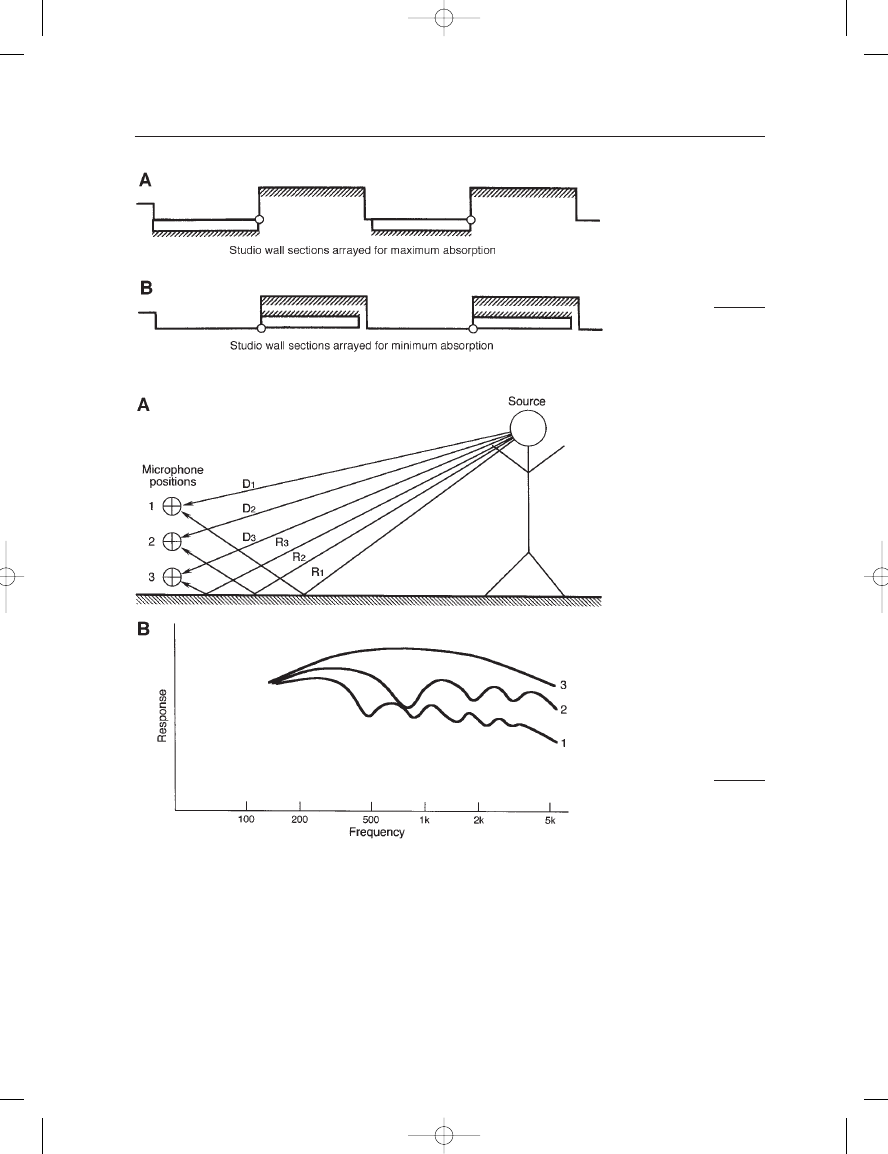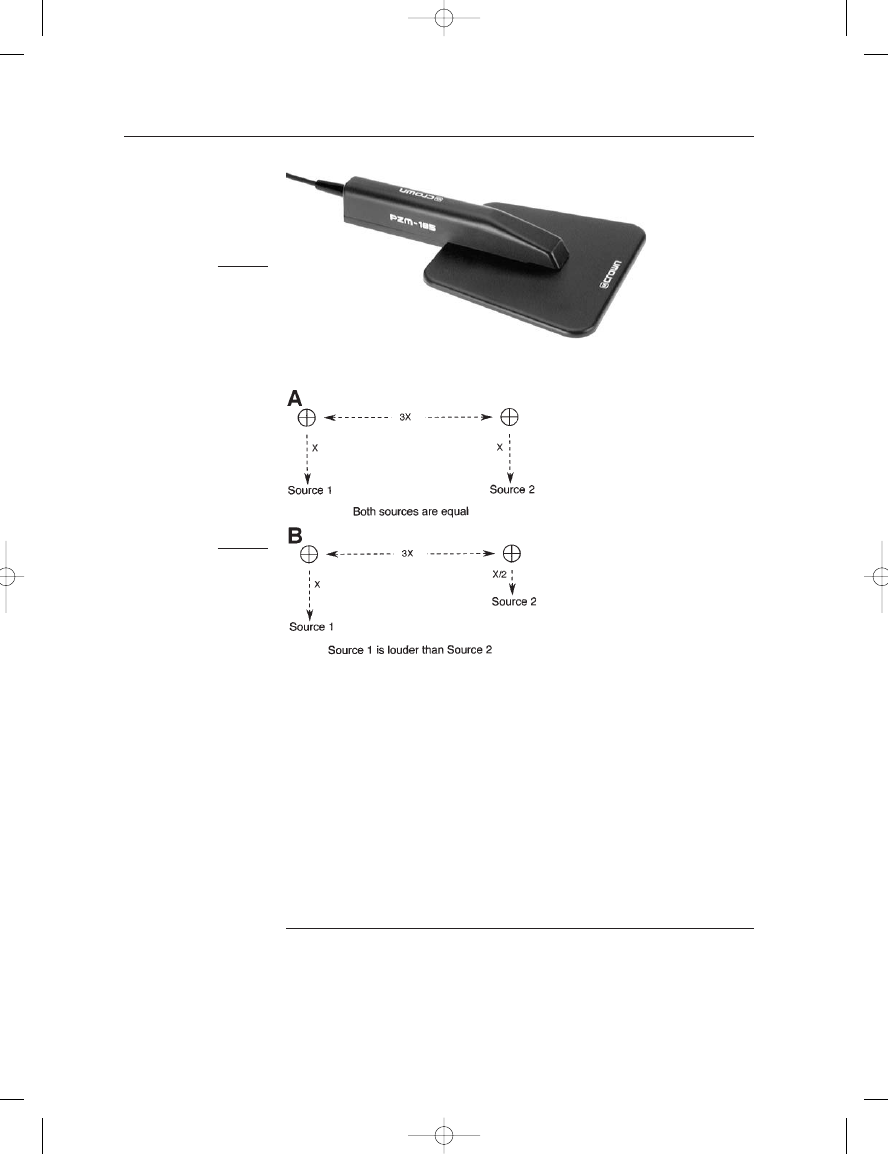ВУЗ: Казахская Национальная Академия Искусств им. Т. Жургенова
Категория: Книга
Дисциплина: Не указана
Добавлен: 03.02.2019
Просмотров: 17288
Скачиваний: 51

behind the trombones, and it is not unusual for the various wind sections
of the band to stand when playing as an ensemble. Stereo pickup of both
saxophones and brass is typical, with accent microphones in place for
solos. The engineer needs accurate cueing from the producer for spotting
the solos. Usually, a single stereo reverberation system will adequately
take care of all ensemble demands for ambience. However, a vocal
soloist would certainly call for an additional reverberation system, most
likely with shorter reverberation time settings.
Target stereo soundstage
Both saxophones and brass are panned across the stereo soundstage to
form a continuous presentation. The spotting of solos, depending on
how extended they may be, are panned into the center. The rhythm ele-
ments form another layer, arrayed in stereo with piano at the left, drums
in the center, and guitar at the right. The overall soundstage is as shown
in Figure 14–23B.
In order to avoid a cluttered setup, most engineers would opt for
stereo microphones for the basic stereo pickup of the saxophones and
the brass. Pickup of the rhythm elements would be in accordance with
the suggestions made earlier in this chapter. The safest approach to
recording a group this complex would be to assign each microphone to
its own recording track, while at the same time making a two-track
stereo monitor mix. There are a number of engineers who are truly
adept at making “live to two-track” mixes of big bands. An automated
console, with adequate subgrouping of inputs, makes the job a bit
easier.
THE LARGE STUDIO ORCHESTRA
As discussed here, the large studio orchestra is typical of the ensemble
that would be used in motion picture sound track scoring. Superficially,
the group may resemble a small symphony orchestra. The main pickup
will in fact look a great deal like those discussed in Chapter 13.
The engineer must determine, in consultation with the composer/
arranger and the recording producer, the requirements of the score. Any
instrument that will be featured in a solo role, however momentary, will
probably need an accent microphone. The reason for this is that post-
production mixing of music tracks behind dialog and/or effects will ordi-
narily require that individual solo instruments be highlighted in order to
be heard effectively in the final film mix. This is a judgment that cannot
readily be made during scoring sessions.
However, the tracks laid down for opening and closing credits may
well be used exactly as balanced by the mixing engineer during the scor-
ing sessions. The only new requirement introduced here is that the mix
will, in today’s creative environment, be done in five-channel format,
three in front plus two surround channels, for motion picture purposes.
THE MICROPHONE BOOK
238
Earg_14.qxd 14/9/04 2:55 PM Page 238

The string ensemble, as in classical recording, always sounds best
when the microphones are no closer than absolutely necessary to delin-
eate them with respect to the winds and brasses. Many a great score has
been ruined by too-close string microphone placement, with its charac-
teristic “screech.” Figure 14–24 shows a typical studio layout for a large
scoring session. Note that the strings are picked up primarily via the
main four microphones across the front and the internal overhead pair
on the inner strings. The accent microphones are used only for high-
lighting solos, and they are often implemented only during postproduc-
tion sessions.
MODERN STUDIO ACOUSTICS AND
CONTROL OF LEAKAGE
Half a century ago, recording studios tended to be fairly dry acoustical
environments in order to meet needs growing out of broadcasting and
film sound recording, with their limited dynamic ranges. Over the
decades we have seen more varied spaces as the recording arts have
evolved. Today’s recording studio is apt to have a number of environ-
ments within a larger space. For example, one end of the studio may be
more acoustically live than the other; or perhaps the entire studio will be
covered with movable wall sections that can be turned inward or out to
create local live or damped playing areas, as shown in Figure 14–25.
14: Studio Recording Techniques
239
FIGURE 14–24
Studio layout for a large
studio orchestra.
Earg_14.qxd 14/9/04 2:55 PM Page 239

Modern studios will have several isolation areas. These are used pri-
marily for vocals and any soft instrumental elements in the mix. Some
studios have a large space, virtually a second studio, adjacent to the main
area and large enough to contain a sizeable string group. Large sliding
glass doors provide the necessary sight lines into the main studio.
Discrete reflections in the studio can be problematic, as shown in
Figure 14–26A. For example, in recording cellos and basses, the micro-
phone may be fairly close to the floor. If the microphone is about
THE MICROPHONE BOOK
240
FIGURE 14–25
Live and absorptive areas in
a modern studio.
FIGURE 14–26
Reflections in the studio:
microphone positions (A);
response (B).
Earg_14.qxd 14/9/04 2:55 PM Page 240

equidistant from the sound source and the floor, as shown at position 1,
the reflected path can create an irregularity in response as shown at B.
Progressively moving the microphone toward the floor will minimize the
response irregularities.
In most cases it is best to place the microphone directly on the floor
and avoid interferences completely. Boundary layer microphones are
specifically designed for this application. A typical model is shown in
Figure 14–27. Normally, an omnidirectional pattern is chosen, but direc-
tional boundary layer microphones can be used if more separation is
required.
THE THREE-TO-ONE RULE
Another problem arises in smaller studios where players are often seated
closer together than is desirable. Figure 14–28A shows what is called the
“three-to-one” rule. That rule states that, when using omni micro-
phones, the distance from a microphone to its target sound source
14: Studio Recording Techniques
241
FIGURE 14–27
A boundary layer
microphone. (Photo
courtesy of Crown
International.)
FIGURE 14–28
The “three-to-one” rule in
omnidirectional microphone
placement: both sources
about equal in level
(A); source 1 louder
than source 2 (B).
Earg_14.qxd 14/9/04 2:55 PM Page 241

should be no greater than one-third the distance from that microphone
to the nearest interfering source. The three-to-one ratio will reduce the
level from the interfering source by an average of 10 dB, which is quite
acceptable. When one instrument is significantly louder than the other,
then the adjustment shown at B must be made. Obviously, using cardioid
microphones will diminish interference problems all the more.
THE MICROPHONE BOOK
242
Earg_14.qxd 14/9/04 2:55 PM Page 242